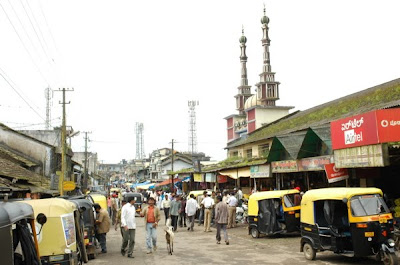 It’s been a few days since I last wrote, but I can’t let this blog go on without talking about our visit to the Tibetan community in Bylakuppe. I had wanted to visit the South Indian monasteries and mingle with Tibetans since we first arrived in Bangalore and cluttered by bus past Kushalnagar some three weeks ago. What with being sick and being initiated into life on the farm here, Matt and I had not had even one true day off yet. So when our first break rolled around last Thursday, we decided to wake up early and catch the bus to Kushalnagar. Chitra and Lauren, the two other interns here, came along as well, and we had a grand time exploring a new corner of India.
It’s been a few days since I last wrote, but I can’t let this blog go on without talking about our visit to the Tibetan community in Bylakuppe. I had wanted to visit the South Indian monasteries and mingle with Tibetans since we first arrived in Bangalore and cluttered by bus past Kushalnagar some three weeks ago. What with being sick and being initiated into life on the farm here, Matt and I had not had even one true day off yet. So when our first break rolled around last Thursday, we decided to wake up early and catch the bus to Kushalnagar. Chitra and Lauren, the two other interns here, came along as well, and we had a grand time exploring a new corner of India.Kushalnagar is in Mysore district in Karnataka, some 1.5 hours from where we live, and outside of Kodagu district, the high-altitude/high-rain area where Mojo Plantation is located and where most Coorgian coffee is grown. While Kushalnagar is still relatively hilly, much of its forests have been cut, and rather than rainforests mingled with coffee and pepper, fields of corn and wheat stretch out across the valleys. With mountains in the distance and green fields in between, we were treated to expansive views of the countryside. According to Chitra, the Tibetans have become experienced agriculturalists since settling here in the 1950s and 60s. Now they’re tending to cows and corn rather than yak and sheep.
The most well known of the temples here is the Golden Temple, an eye-catching golden-domed Nyingmapa Buddhist center with huge statues and paintings inside. While beautiful, it was a tad overwhelming in terms of tourist attention. The temple draws lots of Indian tourists, and because we
 were the only westerners around, a few bold ones followed us around trying to snap photos of us. Happily, we found the kora (circumambulating loop) surrounding the temple and monastery grounds and escaped the crowds. A plethora of prayer wheels and interesting juxtapositions greeted us on the monastery’s outskirts.
were the only westerners around, a few bold ones followed us around trying to snap photos of us. Happily, we found the kora (circumambulating loop) surrounding the temple and monastery grounds and escaped the crowds. A plethora of prayer wheels and interesting juxtapositions greeted us on the monastery’s outskirts.After a lunch of momos and maaza, we met an old woman who explained the system of “camps” that break up the 20,000-strong Tibetan community into neighborhoods localized around five monasteries. Within Tibetan Buddhism there are four different schools of thought: Nyingmapa, Gelugpa, Kagyu, and Shakya. We decided to walk the 4ish kilometers to the Gelugpa monastery, the largest one in the area with 5,000 monks. Good thing, apparently, since foreigners, are not supposed to visit the other three. Yet another reminder that Tibetans are still refugees in this country, even though many of those in South India have been here for 50 years (like the woman we talked to), or their whole lives.
 The walk to Sera Monastery was perhaps the best part of the day. We popped into a few thangka (Tibetan religious paintings) studios on the way, and passed monks and cows on their ways home for the night. We arrived at Sera Monastery to find out that it was the last day of a 10-day vacation for the monks, and the place was fairly deserted.
The walk to Sera Monastery was perhaps the best part of the day. We popped into a few thangka (Tibetan religious paintings) studios on the way, and passed monks and cows on their ways home for the night. We arrived at Sera Monastery to find out that it was the last day of a 10-day vacation for the monks, and the place was fairly deserted.The place, in some ways, felt like a reincarnation of Tibet. Monasteries and prayer flags everywhere you looked, a quiet and calm rarely found in India, and monks in red robes going about their business. I tried my rusty Tibetan out on a few of them, but mostly got confused looks and laughs. I found myself wishing I knew a friend or two amongst them, and hoping to spend more time in Bylakuppe this year. The excursion brought me a little peace, beauty, and even a sense of home.
























